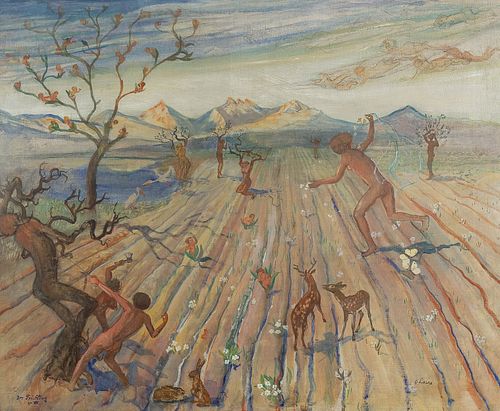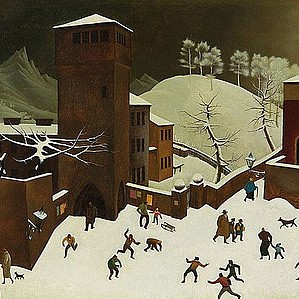OSKAR LASKE (Czernowitz 1874 - 1951 Vienna) Spring, around 1920
Lot 187
Estimate:
EUR€50,000 - EUR€100,000
$52,083.33 - $104,166.67
Absentee vs Live bid
Two ways to bid:
- Leave a max absentee bid and the platform will bid on your behalf up to your maximum bid during the live auction.
- Bid live during the auction and your bids will be submitted real-time to the auctioneer.
Bid Increments
| Price | Bid Increment |
|---|---|
| EUR€0 | EUR€10 |
| EUR€100 | EUR€50 |
| EUR€700 | EUR€100 |
| EUR€1,000 | EUR€200 |
| EUR€3,000 | EUR€300 |
| EUR€3,600 | EUR€400 |
| EUR€4,000 | EUR€500 |
| EUR€7,000 | EUR€1,000 |
| EUR€16,000 | EUR€2,000 |
| EUR€30,000 | EUR€3,000 |
| EUR€36,000 | EUR€4,000 |
| EUR€40,000 | EUR€5,000 |
About Auction
By Widder Auctions
May 19, 2022
Set Reminder
2022-05-19 11:00:00
2022-05-19 11:00:00
America/New_York
Bidsquare
Bidsquare : Masterpieces
https://www.bidsquare.com/auctions/widder-auctions/masterpieces-9287
Masterpieces of classical modernism by Austrian and international artists coming up for auction in Vienna on May 19th Widder Auctions office@widderauktionen.com
Masterpieces of classical modernism by Austrian and international artists coming up for auction in Vienna on May 19th Widder Auctions office@widderauktionen.com
- Lot Description
OSKAR LASKE
(Czernowitz 1874 - 1951 Vienna)
Spring, around 1920
oil tempera/paper, 95 x 117 cm
signed O. Laske and titled Der Frühling Opus XXI
verso label VER SACRUM (FRÜHLING) TEMPERA
exhibited at Künstlerhaus Wien 1952, N. 1328
Provenance: private collection Vienna, Fine Arts Widder, Auction im Kinsky 2009, private collection
ESTIMATE °€ 50.000 - 100.000
Austrian painter, graphic artist, book illustrator and architect of the 20th century, especially of the interwar period. Studied architecture at the Academy under Otto Wagner. Apart from a course in landscape painting with Anton Hlavacek, self-taught painter. From 1905 member of the Jungbund, from 1907 member of the Hagenbund, from 1924 in the Vienna Secession and from 1928 in the Künstlerhaus. Travels through Europe to North America. Early landscapes and cityscapes with infusions of atmospheric Impressionism. Created biblical, historical and genre scenes, with a preference for narrative and multi-figure representations. Imaginative, detailed and humorous with an expressive yet sensitive use of color.
Oskar Laske, 1874 as the eldest son of the architect Oskar Laske senior and his wife Xavera, daughter of the Czernowitz master builder Anton Fiala, first studied architecture in Vienna at the Technical University and with Otto Wagner at the Academy. After graduating, Laske began practical work in the cottage association with building director Hermann Müller, and a year later continued his architectural studies at the Academy of Fine Arts with Otto Wagner. Laske joined his father's construction company in 1901 and worked there in the field of residential building architecture, built villas and country houses in Vienna and the surrounding area as well as factories and was considered a sought-after interior decorator. However, in 1904 Laske decided to pursue an artistic career as an autodidact. In 1907 he joined the Hagenbund and in 1924 the Vienna Secession, where he was regularly represented in exhibitions. Even before the outbreak of the First World War, Laske embarked on extensive painting and study trips that took him through Europe, the Middle East and North Africa. During the war, Laske first served as an officer in Galicia and subsequently on the particularly bloody Isonzo front. Later he became a k. u. k. (“imperial and royal”, referring to the Habsburgs dual monarchy Austria-Hungary) war painter. This watercolor belongs to the series of rural genre paintings by Laske. Such views of Laske come from the precarious years during the Second World War, also for this artist, in which Oskar Laske embarked on a kind of “inner emigration”. However, as far as circumstances allowed him, he maintained the spiritual and intellectual private circle in his house that had built up over the decades. From this time on, his extensive travel activity also decreased, and he concentrated on views of Vienna and the surrounding area, in which he remained true to his compositional idiosyncrasies.
PLEASE NOTE:
The purchase price consists of the highest bid plus the buyer's premium, sales tax and, if applicable, the fee of artists resale rights. In the case of normal taxation (marked ° in the catalog), a premium of 24% is added to the highest bid. The mandatory sales tax of 13% is added to the sum of the highest bid and the buyer's premium. The buyer's premium amounts to 28% in case of differential taxation. The sales tax is included in the differential taxation. - Shipping Info
-
Shipping
We will send you the invoice shortly after the auction. As soon as we have recieved the amount, the art can be picked up at Johannesgasse 9-13, 1010 Vienna. Please note that the buyer is responsible for pick-up and shipping of the lot.
Should you wish to ship your items, please contact: Mailboxes Email: oper@mbe-co.at Tel: 01 5128855
Please note that storage fees may apply, should the pieces not be picked up within 14 days after invoicing for domestic and 28 days for international transportation.
Our team will be happy to assist you with any further information at office@widderauktionen.com or at 0043 676 555 66 10.
-
- Buyer's Premium



 EUR
EUR CAD
CAD AUD
AUD GBP
GBP MXN
MXN HKD
HKD CNY
CNY MYR
MYR SEK
SEK SGD
SGD CHF
CHF THB
THB













